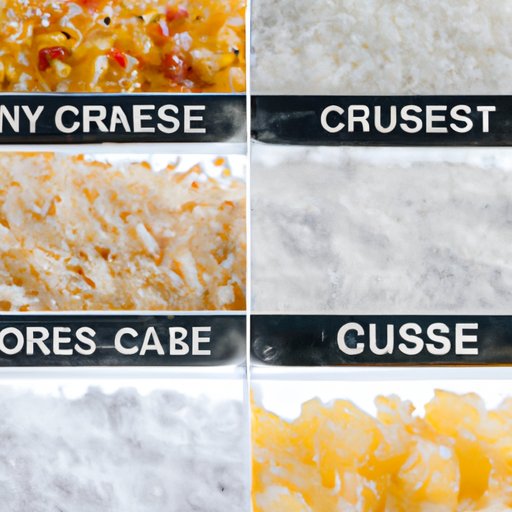
I. Introduction
Cornstarch is a common thickening agent used in many cooking and baking recipes. However, for those who are unable or unwilling to use cornstarch, there are several alternatives that can be used. This article aims to explore a variety of alternative options that can be used in place of cornstarch, including natural, low-carb, gluten-free, international, and creative alternatives.
II. Natural Plant-Based Alternatives
Using natural plant-based ingredients as alternatives to cornstarch is an excellent option for those who are looking for healthier and unprocessed alternatives. Tapioca starch is a popular alternative that comes from the roots of the cassava plant. It has a similar texture to cornstarch and can be used in equal parts in most recipes. Arrowroot powder is another plant-based option that comes from the roots of the arrowroot plant. It has a smoother texture than cornstarch and can be used in equal portions in most recipes. Potato starch is another great alternative that comes from peeled and dried potatoes. It is a gluten-free ingredient and can be used as a substitute for cornstarch in many recipes.
Recipes that use these alternatives include Tapioca Flour Pizza Dough, Arrowroot Pudding, Gluten-Free Crunchy Onion Rings, and Vegan Potato Starch Gnocchi.
III. Low-Carb Alternatives
For those following a low-carb diet or looking to reduce their carb intake, using low-carb alternatives to cornstarch is an excellent option. Xanthan gum is a popular alternative that is often used in gluten-free baking. It is made from fermented corn sugar and is a great thickening agent for sauces and gravies. Guar gum is another low-carb alternative that is widely used in gluten-free baking. It is made from guar beans and has a similar texture and taste to xanthan gum.
Recipes that use these alternatives include Low-Carb Keto Gravy, Low-Carb Coconut Flour Pancakes, and Gluten-Free, Low-Carb Ice Cream.
IV. Gluten-Free Alternatives
For those with gluten intolerances or celiac disease, cornstarch may not be a suitable option. However, there are several gluten-free alternatives that can be used instead. Almond flour is an excellent gluten-free alternative that is made from ground almonds. It is rich in protein and healthy fats and can be used in baking as well as savory dishes. Coconut flour is another gluten-free alternative that is made from dried, ground coconut meat. It is high in fiber and low in carbohydrates and can be used as a thickening agent in sauces and gravies. Rice flour is another great gluten-free alternative that is often used in Asian cooking. It has a light texture and can be used in equal parts as cornstarch in most recipes.
Recipes that use these alternatives include Gluten-Free Baked Chicken Tenders, Keto Almond Flour Bread, and Vegan Coconut Flour Brownies.
V. Alternatives for Baking
Cornstarch is often used in baking for thickening pie fillings and custards. However, there are several alternatives that can be used instead. Flour is a common alternative that can be used in equal parts as cornstarch. Tapioca flour is another alternative that can be used in equal parts and has a similar texture to cornstarch. Mashed sweet potato is another excellent alternative that is often used to thicken pumpkin and sweet potato pies.
Recipes that use these alternatives include Sweet Potato Custard Pie, Tapioca Flour Banana Bread, and All-Purpose Flour Chocolate Cake.
VI. International Alternatives
Alternative ingredients are used in different cultures for cooking and baking purposes. Mung bean starch is a popular ingredient in Asian cooking and is often used as a thickening agent in soups and sauces. Chickpea flour is another popular substitute that is used in Middle Eastern cooking and as a binding agent in vegan dishes.
Recipes that use these alternatives include Spicy Mung Bean Noodle Soup, Chickpea Flour Vegan Omelet, and Indian Besan Ladoo.
VII. Creative Alternatives
Some alternative thickening agents might surprise you. Ground chia seeds are an unconventional thickener that can be used in sauces, dressings, and jams. Psyllium husk is another alternative that is often used in keto baking as a binding agent. White bread is a unique alternative that can be used in place of cornstarch in meatloaf recipes.
Recipes that use these alternatives include Chia Seed and Strawberry Jam, Keto Bread Recipe with Psyllium Husk, and Paula Deen’s Meatloaf with White Bread.
VIII. Conclusion
Whether you have a dietary restriction or are looking for a healthier or more diverse options, there are several alternatives to cornstarch that you can use in your cooking and baking. Natural, low-carb, gluten-free, international, and creative alternatives can provide you with a wide range of options to experiment with. Remember to follow the recommended proportion guidelines when substituting cornstarch with these alternatives. Happy cooking and baking!
Recommended: Try using different alternatives to cornstarch in your favorite recipes to see what works best for your taste preferences and dietary needs.




